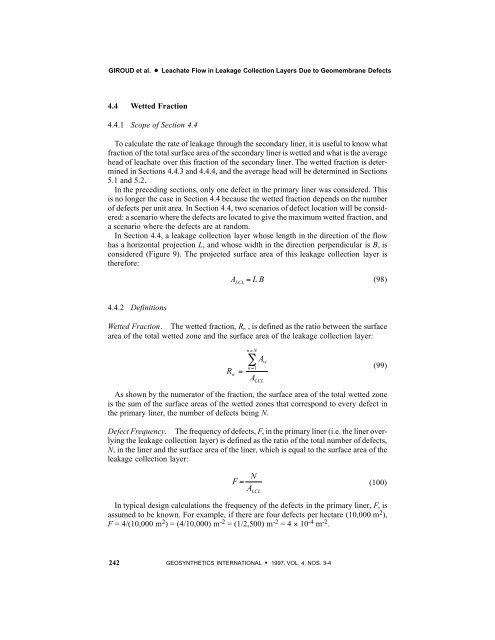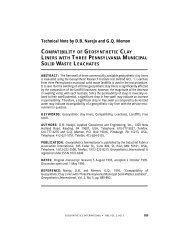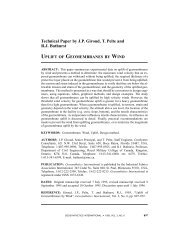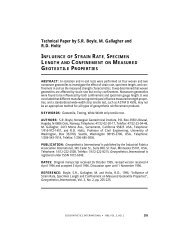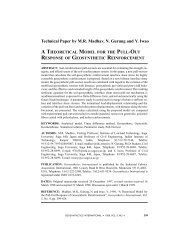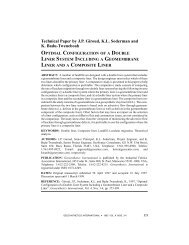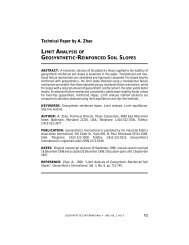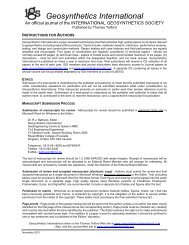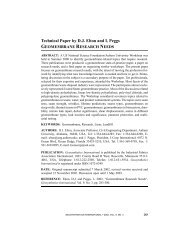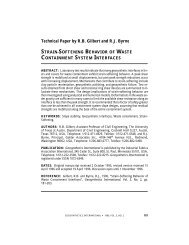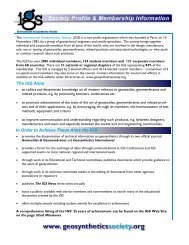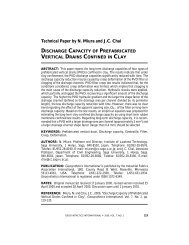leachate flow in leakage collection layers due to defects in ...
leachate flow in leakage collection layers due to defects in ...
leachate flow in leakage collection layers due to defects in ...
Create successful ePaper yourself
Turn your PDF publications into a flip-book with our unique Google optimized e-Paper software.
GIROUD et al. D Leachate Flow <strong>in</strong> Leakage Collection Layers Due <strong>to</strong> Geomembrane Defects<br />
4.4 Wetted Fraction<br />
4.4.1 Scope of Section 4.4<br />
To calculate the rate of <strong>leakage</strong> through the secondary l<strong>in</strong>er, it is useful <strong>to</strong> know what<br />
fraction of the <strong>to</strong>tal surface area of the secondary l<strong>in</strong>er is wetted and what is the average<br />
head of <strong>leachate</strong> over this fraction of the secondary l<strong>in</strong>er. The wetted fraction is determ<strong>in</strong>ed<br />
<strong>in</strong> Sections 4.4.3 and 4.4.4, and the average head will be determ<strong>in</strong>ed <strong>in</strong> Sections<br />
5.1 and 5.2.<br />
In the preced<strong>in</strong>g sections, only one defect <strong>in</strong> the primary l<strong>in</strong>er was considered. This<br />
is no longer the case <strong>in</strong> Section 4.4 because the wetted fraction depends on the number<br />
of <strong>defects</strong> per unit area. In Section 4.4, two scenarios of defect location will be considered:<br />
a scenario where the <strong>defects</strong> are located <strong>to</strong> give the maximum wetted fraction, and<br />
a scenario where the <strong>defects</strong> are at random.<br />
In Section 4.4, a <strong>leakage</strong> <strong>collection</strong> layer whose length <strong>in</strong> the direction of the <strong>flow</strong><br />
has a horizontal projection L, and whose width <strong>in</strong> the direction perpendicular is B, is<br />
considered (Figure 9). The projected surface area of this <strong>leakage</strong> <strong>collection</strong> layer is<br />
therefore:<br />
A<br />
LCL =<br />
LB<br />
(98)<br />
4.4.2 Def<strong>in</strong>itions<br />
Wetted Fraction. The wetted fraction, R w , is def<strong>in</strong>ed as the ratio between the surface<br />
area of the <strong>to</strong>tal wetted zone and the surface area of the <strong>leakage</strong> <strong>collection</strong> layer:<br />
R<br />
w<br />
n<br />
N<br />
=<br />
∑<br />
n<br />
= = 1<br />
A<br />
A<br />
LCL<br />
w<br />
(99)<br />
As shown by the numera<strong>to</strong>r of the fraction, the surface area of the <strong>to</strong>tal wetted zone<br />
is the sum of the surface areas of the wetted zones that correspond <strong>to</strong> every defect <strong>in</strong><br />
the primary l<strong>in</strong>er, the number of <strong>defects</strong> be<strong>in</strong>g N.<br />
Defect Frequency. The frequency of <strong>defects</strong>, F, <strong>in</strong> the primary l<strong>in</strong>er (i.e. the l<strong>in</strong>er overly<strong>in</strong>g<br />
the <strong>leakage</strong> <strong>collection</strong> layer) is def<strong>in</strong>ed as the ratio of the <strong>to</strong>tal number of <strong>defects</strong>,<br />
N, <strong>in</strong> the l<strong>in</strong>er and the surface area of the l<strong>in</strong>er, which is equal <strong>to</strong> the surface area of the<br />
<strong>leakage</strong> <strong>collection</strong> layer:<br />
F =<br />
N<br />
A LCL<br />
(100)<br />
In typical design calculations the frequency of the <strong>defects</strong> <strong>in</strong> the primary l<strong>in</strong>er, F, is<br />
assumed <strong>to</strong> be known. For example, if there are four <strong>defects</strong> per hectare (10,000 m 2 ),<br />
F = 4/(10,000 m 2 ) = (4/10,000) m -2 = (1/2,500) m -2 =4× 10 -4 m -2 .<br />
242 GEOSYNTHETICS INTERNATIONAL S 1997, VOL. 4, NOS. 3-4


